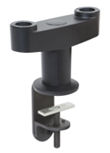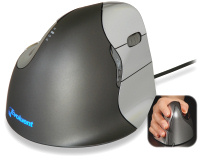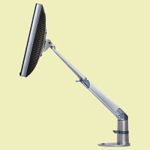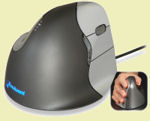
September 2010
In this issue...
- Featured New Products: The VerticalMouse 4 from Evoluent
- Featured Promo: EVO LCD 'Modern' Arm by IOP (45 ° model only)
- New Products: Dual Arm Mount (8408) by IOP
- Ergonomic Workstation Tip of the Month: The Pros and Cons of Vertical Mousing Devices
- Ergonomic Product Tip of the Month: The Evoluent VerticalMouse 4 vs. VerticalMouse 3
- Upcoming Events: ACE Conference in Kelowna, B.C.
New Products
Dual Arm Mount by IOP is Now Available!
 With the Dual Arm Mount from IOP you can mount two flat panel monitors in any position you desire. The Dual Arm's articulating gas arms (purchased separately) provide complete freedom of motion. The monitors float in place - simply nudge to the desired position. Position each monitor independently of the other, and quickly adjust pivot and placement as your needs change.
With the Dual Arm Mount from IOP you can mount two flat panel monitors in any position you desire. The Dual Arm's articulating gas arms (purchased separately) provide complete freedom of motion. The monitors float in place - simply nudge to the desired position. Position each monitor independently of the other, and quickly adjust pivot and placement as your needs change.
For more information on the Dual Arm Mount, see the LCD Accessories page in our online catalog.
Ergonomic Workstation Tip of the Month
The Pros and Cons of Vertical Mousing Devices
No single mouse design acts as a magic wand which will address all mouse-related risk factors for injury. Although ergonomic analysis can tell us what is causing these injuries with respect to general designs, it cannot make the leap from such analyses to some universal design that incorporates all that understanding. It is up to the manufacturers of ergonomic products to focus on what problems they wish to address for their customers. Vertical mousing devices are no exception to this rule.
Vertical mousing devices, like the Evoluent VerticalMouse 4 or 3M Ergonomic Mouse, appeal to a particular group of users who experience pain when their hands are pronated, that is, twisted flat or parallel to the mousing surface in order to use the mouse. When mice were first designed, no one anticipated that high usage of the mouse in this position would cause hand injuries, but given that it does so in certain users, it was only a matter of time before manufacturers realized that a new design was needed for such individual. Thus the Vertical Mouse was born.
Apart from pronation of the hand, which is also connected with forearm twisting, some users of traditional mice developed the bad habit of bending excessively at the wrist in a side-to-side motion, a condition of the wrist and forearm usually called 'ulnar deviation'. This is allowed to happen in certain users because there is nothing naturally obstructing the hand and wrist from doing so. With the introduction of a vertical mousing device, however, which keeps the hand in a 'handshake' position, ulnar deviation is prevented because the hand rests on a surface, either the desk or mouse's own support, making such motion difficult, if not impossible, to achieve. Vertical mousing devices thus help prevent or minimize two important risk factors for mousing-related injuries: pronation and ulnar deviation. In part, the benefits of the vertical mousing device are explained by the fact that the hand and arm are closer to their natural or normal 'relaxed' positions when using such mice.
But vertical mice are not necessarily for everyone, since they, too, have limitations on all the possible injuries that can be prevented. Although pronation and ulnar deviation can be largely prevented by such mice, they are sometimes less effective in preventing another risk factor when mousing: wrist extension. Wrist extension occurs when the wrist is bent in an upwards direction, either continuously or repetitively, relative to the direction of the forearm. In a way, by solving ulnar deviation so effectively by preventing side-to-side motion while pronating, the vertical mouse can then encourage wrist extention in the 'handshake' position that mimics the side-to-side motion of ulnar deviation: this side-to-side motion in ulnar deviation is simply translated into the upward bending at the wrist in wrist extension. Unfortunately, there must be some trade-offs in replacing one mouse design with another, and so in these cases, it is strongly encouraged that the user not only adopt the mousing device that best addresses their issues but also actively change their mousing habits so that other injuries can be prevented or minimized before they develop into serious, painful injuries.
There is no doubt that vertical mousing devices are of great benefit to a large group of mouse users, and that not all users of vertical mice will develop negative side-effects like wrist extension. Properly used and with reasonable usage, vertical mousing devices have more advantages than disadvantages and play an essential part in the prevention of well-known problems like pronation and ulnar deviation. As long as one knows both the pros and cons of vertical mousing devices, good decisions can be made to ensure that one finds the most appropriate device for oneself.
Ergonomic Product Usage Tip of the Month
The Evoluent VerticalMouse 4 vs. VerticalMouse 3
 The new Evoluent VerticalMouse 4 (VM4) has added a number of new features, along with a newly designed shape, to the VerticalMouse brand, some of which are noteworthy in comparison to the now discontinued VerticalMouse 3 (VM3). Of course, the basic concept behind both versions of the VerticalMouse - preventing or minimizing forearm twisting by keeping the hand in a 'neutral' or 'handshake' position' - remains the same. But for those who have already used an earlier version of the VerticalMouse and want to know what changes have been made, here is a brief summary of the main differences between the two:
The new Evoluent VerticalMouse 4 (VM4) has added a number of new features, along with a newly designed shape, to the VerticalMouse brand, some of which are noteworthy in comparison to the now discontinued VerticalMouse 3 (VM3). Of course, the basic concept behind both versions of the VerticalMouse - preventing or minimizing forearm twisting by keeping the hand in a 'neutral' or 'handshake' position' - remains the same. But for those who have already used an earlier version of the VerticalMouse and want to know what changes have been made, here is a brief summary of the main differences between the two:
1. The VerticalMouse 4 comes in both left-handed and right-handed versions. Unlike the VM3, which is right-handed only, the VM4 now includes a left-handed model. An earlier version of the VerticalMouse, the VM2, did come in a left-handed model, but that model obviously did not include the added features of the VM3, such as the lower lip that supports the little finger and multiple pointer speeds. Left-handed users can now enjoy both these newer features that have been further enhanced in the VM4.
2. The VerticalMouse 4 is more comfortable for a wider range of hand types. The newly sculpted shape of the VM4 allows different hand types to position their hands more comfortably on the mouse, so that usage is now easier. The lower lip is larger than the VM3, preventing larger hands from dragging on the mousing surface, while the indentation for the thumb has rounder and smoother curves, making gripping the mouse seem less stressful to the hand. The buttons also have a slight downward angle (compared to the VM3), which may help smaller than normal hands to target the buttons better without spreading the fingers in an awkward way. All these slight changes make the overall usage of the VM4 noticeably more comfortable than the VM3.
3. Enhanced programmability of the VerticalMouse 4 through a sixth button. The VM4 now has a sixth programmable button compared to the five programmable buttons on the VM3. The sixth button, located on the lower bottom edge of the thumb indentation, allows the user to program it in addition to the other five buttons, including programming it to perform a 'toggle' function. The toggle function introduces a second layer of programming in the first, second, third, and fourth buttons, giving a total of nine programmable button functions overall.
4. Ease of adjusting pointer speed on the fly. The VM3 introduced the possibility of adjusting pointer speed to four different settings, from low to high, to give the user finer control over mouse movements on the screen. In order to adjust these speeds, a button on the bottom of the mouse was used, together with an indicator light to show the various settings. In the VM4, the user still can adjust these settings, but the mechanism to do so has been placed on the upper part of the mouse next to the front buttons, so that the user can adjust these settings on the fly without having to stop what they are doing and turn the mouse over. The indicator light is also on the upper mouse towards the back and top, for easier viewing. Now the user can work continuously without having to interrupt his or her work to adjust pointer speed.
These changes between the VM4 and VM3 are not insignificant, especially for those who make use of the above features regularly. The improvements and additions to the VM4, including the introduction of the left-handed model, should accommodate a wider range of users while pleasing existing VerticalMouse users who want to use the latest version of the brand.
Featured New Products
The VerticalMouse 4 from Evoluent
The VerticalMouse 4 is the fourth generation of the popular Evoluent mouse. The flange along the bottom right edge has been increased to prevent the user's little finger from dragging on the desk. Also, the thumb rest has been improved to provide even more comfort over earlier versions. An additional thumb button is also now included in the design. There is now a pointer speed control button on the side of the mouse allowing the user to select between Extra Low, Low, Medium and High. This makes adjusting pointer speed easier and further improves tracking.
The VerticalMouse 4 is available in both a left and right-handed model, with a dark grey housing and silver buttons.
SPECS: USB (not PS/2 compatible)
Dimensions: 4.375" D x 3.5" W x 3.15" H
Weight: 150 g
For more information on the VerticalMouse 4, see the Vertical Mice category in our online catalog.
Featured Promo of the Month
EVO LCD 'Modern' Arm by IOP (45 ° model only)

This LCD mount is a modern, ultra-slim arm designed to complement any modern office. Installation is simple with a built-in desk-clamp or grommet mechanism. The arm can easily and intuitively be adjusted with minimal effort. This is an arm designed to bring back elegance to the office while maintaining functionality. A Quick Release adapter is included with arm.
SPECIFICATIONS for model 5545-450-QR-FM (45°)
Vertical Adjustment: 8" to 18"
Horizontal Adjustment: 16"
LCD Weight: 13-21 lbs
Cable Management: External Clips
Mount: Desk-Clamp or Grommet
VESA Compliant
Regular price: $250.00 each
Sale Price: $200.00 each
See the EVO LCD 'Modern' Arm in the Flip N Find category of our online catalog.
Upcoming Events
ACE Conference in Kelowna BC in October 2010
ErgoCanada will be involved in the upcoming ACE Conference in Kelowna BC, October 4th - 7th, 2010. We are facilitating a pre-conference workshop entitled Ergonomic Products: What Works and When and also participating in the Exhibitor Showcase. The exhibits are open to the general public from 1:30 to 3:00 on Wednesday, October 6th.
RSS Feeds
Copyright © 2010 Micwil Group of Companies Ltd.

